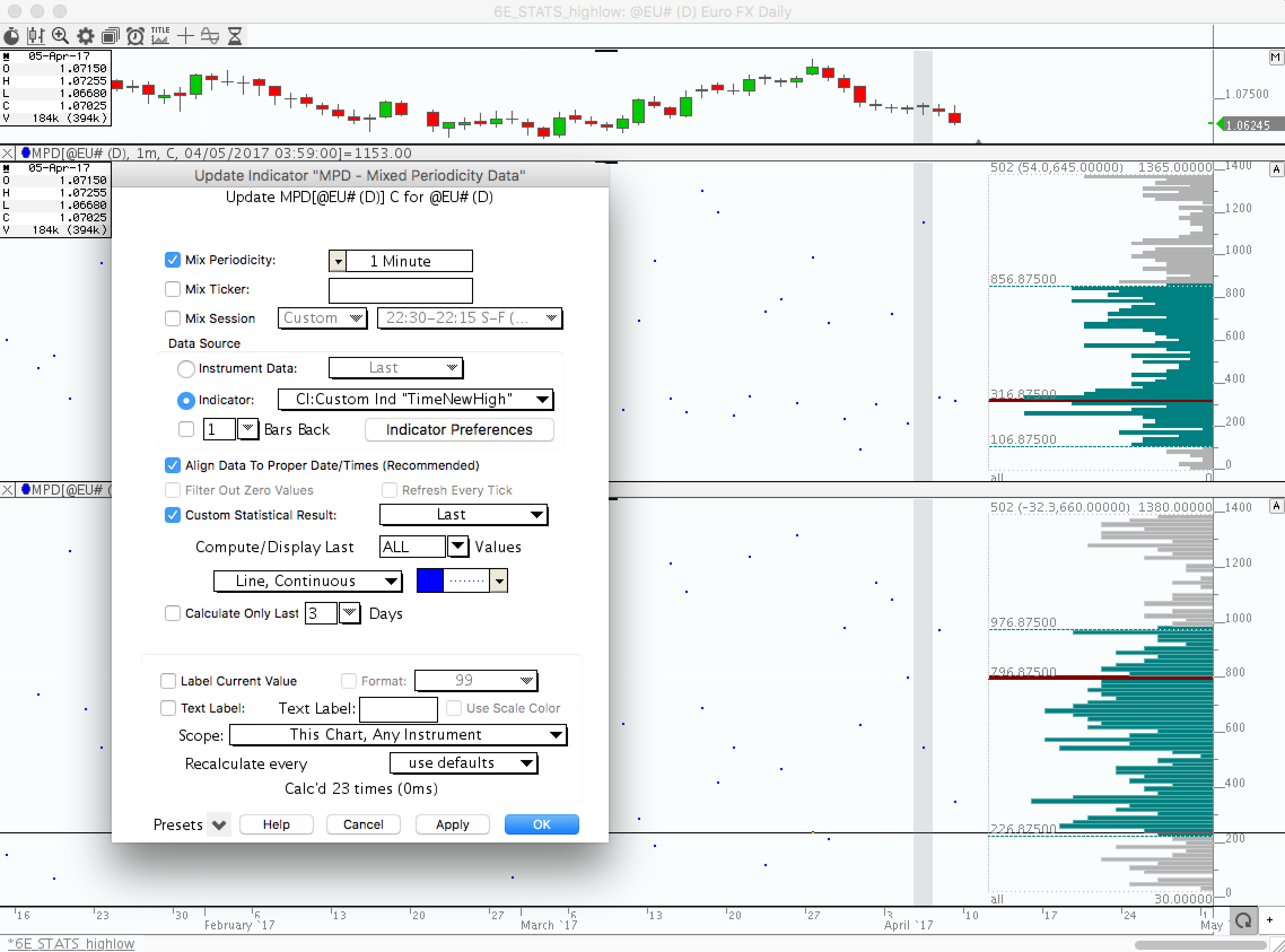Hello everyone!
Being new to IRT I figured I could learn something by trying to convert the time into session HIGH / LOW statistics from homework #25 (https://www.linnsoft.com/videos/extracting-market-behavior-webinar) to the 6E / EURUSD Futures symbol.
I've created a daily chart, added the MPD 1min in a new pane and pointed it to the Custom Indicator "TimeNewHigh".
It does kind of work but the results are all wrong.
The problem with figuring out what exactly is wrong is now that I don't completely understand how / why this indicator works yet. Maybe someone can explain a few things to me.
TimeNewHigh doesPOS - SSTAT which if I understand correctly is supposed to return the index of the bar printing the highest high (in 1min context this equals to minutes since session start).SSTAT is then defined as 20,NewHigh (why 20 period here?!) and NewHigh defined as a signalHI > SESST_HI.1 OR POS = 1 SESST_HI returns the "Highest High of All Bars of Session".
Why do we use .1 here? Does this also go back one bar (and not one session in this context) and is only used to produce a boolean result via "this HI vs. highest high of all _previous_ bars"?
Given all of this is correct and nothing has changed in IRT since it the indicator was written, why do I still get the wrong time into session?
I'm using session 41 "Treasuries / FX FULL 0500-0400" (is this maybe wrong?).
For example for Apr. 7th the indicator produces a high around 315. The High was clearly during NFP (12.30 GMT / UTC, 14.30 my local time).
I've attached a chart with my MPD preferences, maybe I did something wrong there?!
Any help would be much appreciated!
Have a great day!
Nic



First you have your chart set to Daily instead of "Time Per Bar: 1 Day". You can click on the chart and just hit the * key and it should switch over to 1d* instead of D. If you see 1d* it's "Time Per Bar: 1 Day" and if you see D it's Daily. Daily is just using the Daily bars returned from data feed. 1d* bars builds the daily bars from the 1-min / intraday data, and thus can conform to the session of the chart (day session) while Daily (D) is always full session data. There are other benefits, but keep in mind you are looking for 1d* (Time Per Bar: 1 day).
Within the SSTAT, that period (20) is not being used. You should see the period parameter disabled signifying it's not being used in this context. SSTAT is just telling us how many bars it's been since the high was put in.
As far as...
HI > SESST_HI.1 OR POS = 1
POS is setup as "bars from start of session" so this makes sure we identify the 1st bar of session which always puts in (sets) a new high. Beyond that, the high of the bar must be above the highest high of the session as of the previous bar. The SESST_HI is setup to compute highest high of the session (developing) and the .1 means 1 bar back. So this signal will be true on any bar that creates a new high of the session. And the latest/last signal of the day is the one that set the ultimate high of day.
Now let's look at...
POS - SSTAT
POS in this context is setup with "minutes from start of session". And via MPD, we are looking at the value on the LAST 1-min bar within each day. So on that last bar, POS gives us the number of minutes into session of the last bar, then subtracts the bars back that the high was put in, leaving the number of minutes INTO the session that the high was made.
This is somewhat complex, but you should be able to simply import the original chart, and change the symbol and/or session of the chart and it should work fine for any symbol and any session (assuming you leave the periodicity as 1d*).
Thanks a lot for the explanation, it turns out the 1Day vs 1d* was indeed the problem and I simply wasn't aware of the significance.
Everything works well now, I appreciate you help!